On December 29, 2019, the 4th Division announced that “after achieving the desired goals in Latakia” it would be redeploying its units to Aleppo “for new victories.” It is unclear what goals the 4th Division had achieved in Latakia. Since 1 May 2019, elements of the 4th Division, along with a host of other pro-regime forces, have lost hundreds of men and at least a dozen armoured vehicles in countless failed attempts to seize the strategic town of Kabani and its fortified hill, Jabal Zuwayqat. Throughout the offensive, rebels launched their own attacks against poorly fortified regime outposts across the Latakia mountain range. This report examines the eight-month battle for Kabani using satellite imagery, Facebook posts from pro-regime units, and an extensive interview with a coastal loyalist fighter with direct contacts on the Latakia front.
The Long-Contested Mountains
Rebel forces have held a foothold in Syria’s Latakia province for nearly the entirety of the country’s civil war. The Alawite heartland and home to the Assad clan’s ancestral home of Qardaha, Latakia province holds a special place within loyalist circles. The threat rebel forces posed to this crucial mountain front became brutally apparent on August 4, 2013 when several hardcore Salafist factions launched a new offensive here. Led by ISIS, rebel groups rapidly overran government outposts and seized 10 Alawite villages. According to an investigation carried out by Human Rights Watch, ISIS and it’s allied Salafist factions executed at least 190 civilians and kidnapped 200 more.1.“Executions, Indiscriminate Shootings, and Hostage Taking by Opposition Forces in Latakia Countryside” : HRW
The brutality and bare sectarianism of this attack laid clear the urgency for the regime to secure this front. By August 19, 2013 regime forces had pushed the rebels back to the pre-offensive frontline.2.“Assad’s forces push back rebels in Syria’s Alawite mountains” : Reuters While bouts of fighting would continue to occur in this region for the next two years, it was the rebel capture of Jisr al-Shughur on April 25, 2015 that again brought into question the security of Latakia.3.“Islamist fighters seize Syria’s Jisr al-Shugour” : Reuters
Jisr al-Shughur represents both the key to Idlib city from the west, as well as the key to the mountains from the rolling plains of Idlib province in the east. The seizure of the small mountain town of Kabani in August 2016 became the linchpin of the rebel’s defence of their Idlib gains. Kabani and its hill to the south, know as hill 1154 or Jabal Zuwayqat, overlook all rebel-held territory in the plains of northwest Hama province and the hills of western Idlib. This position also provides rebel forces with fire control over a huge amount of the valley below, the current demarcation between rebel and regime forces in the mountains.

Operation Overview
According to a loyalist fighter with contacts on the front, the Kabani operation was initially planned to be a dual defensive-offensive operation conducted under a large operations room encompassing many pro-government units. The May 15 arrival of Air Force Intelligence (AFI) Deputy Commander Ghassan Ismail – now head of the AFI – in Salma, Latakia highlights this intent.4.“Syria replaces security chief: news reports” : Reuters Ismail intended to take command of a military operations room uniting all pro-regime forces in the province: regular SAA units like the 4th and 5th Corps, auxiliary units like the Border Guards and NDF, “elite” units such as the Republican Guard and 4th Division, and all allied militias, particularly the Tiger Forces and Coastal Shield Brigade. But the 4th Division, under the command of Colonel Ghaith Dalah, refused assistance from the bulk of these forces and continued its assault with only minimal support from some auxiliary units who shared the division’s Iranian backing.
The following table shows the pro-regime units that reported losses at any point during the offensive – indicated with an ‘x‘ – and the pro-regime units which were active on the front as per their social media posts but to which no losses can be confidently attributed – indicated with a ‘c‘.
Pro-regime units that were active on the Kabani and broader Latakia front.
| 4th Division | National Defence Forces (NDF) |
| 977th Battalion x | Mountain Battalion c |
| 555 Regiment x | Golan Regiment c |
| 40th Brigade x | Latakia NDF c |
| 42nd Brigade x | Local Defence Forces (LDF) |
| – Muqdad Battalion x | Fauj Qamr Bani Hashim x |
| – Old Damascus Battalion x | Special Forces x |
| – Raoud Battalion x | Saraya Ra’ad |
| – 185th Battalion x | – 3rd Company x |
| — Hourayra Group x | Aleppo Special Tasks Battalion x |
| – Al-Lord Group x | Syrian Hezbollah |
| – Kuwasir Group x | Ridha Forces x |
| – al-Ighwani Group x | Hurras al-Fajr |
| – Abu Jaafar Group x | Suicide Battalion x |
| – Zakiyah and Bakar Groups x | SSNP x |
| – Lebanese Baath Forms x | Yalda Group x |
| Border Guards | Coastal Shield Brigade |
| 11th Regiment | Naval Forces/Syrian Marines x |
| 5th Regiment | Free Palestine Movement |
| 4th Corps | Aqsa Shield Forces |
| 6th Division x | – Badr Company x |
| 2 Division x | Arab Nationalist Guard x |
| – 144th Brigade c | Tiger Forces |
| 5th Corps c | Yarob Regiment c |
| 1st Storming Brigade | Ali Sheli Hawks c |
| – 1st or 1473rd Battalion x | Haider Regiment x |
| 48th Special Forces Regiment x | Shawaheen Hawks |
| 1st Division | 2nd Battalion x |
| Commando Regiment | Komeet Forces |
| – 3rd Battalion x | – Heavy Machinegun Battalion x |
| — 1st Storming Company x |
The bulk of attacks on Jabal Zuwayqat comprised of the deployment of small groups of infantry – anywhere from 5 to 15 men – directly up the hill. At times the infantry was supported with one or two armoured vehicles or with mortar and artillery fire. The armoured vehicles utilised included BMPs, tanks of various models, armoured bulldozers, and armoured recovery vehicles (ARV) which both provided protection on the exposed hill and attempted to recover damaged tanks.
Armoured bulldozers were first employed on August 13 and were used in an attempt to build fortifications atop the mountain.5.https://twitter.com/QalaatAlMudiq/status/1161348636925714433 All armoured vehicles were operated by the 4th Division. A video of an unsupported infantry attack can be viewed here and a video of a rocket-supported infantry attack can be viewed here.
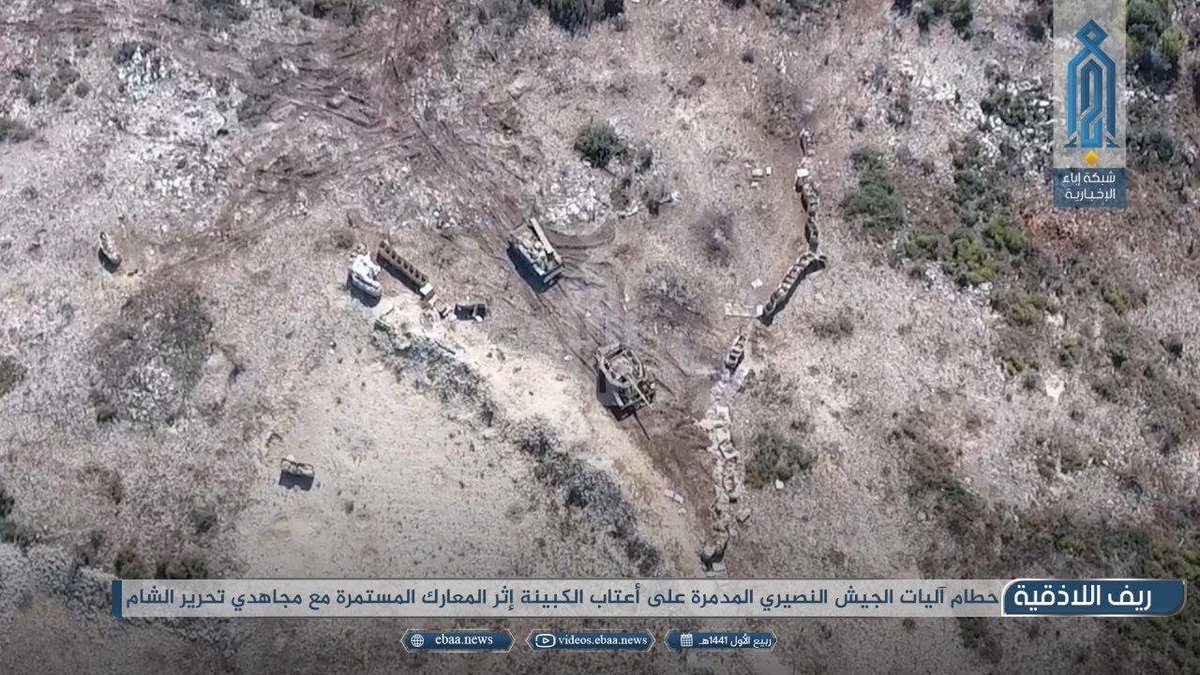
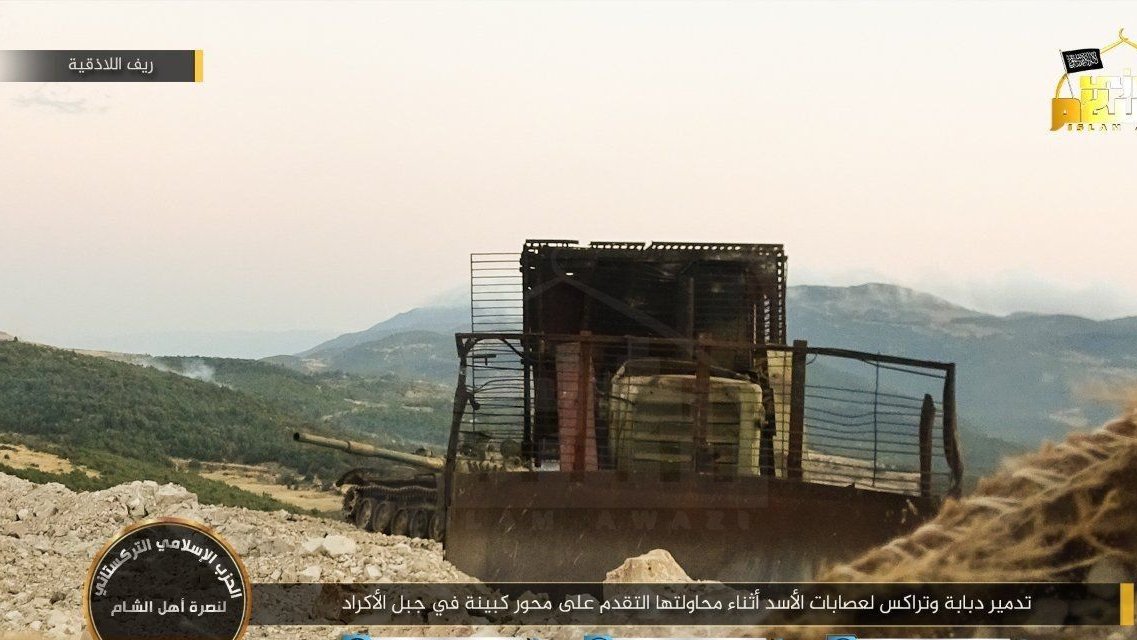
Rebel forces utilised anti-tank mines, ATGMs, RPGs, and mortars to repel and destroy regime armour. Much of the media propaganda released from rebel factions involved drone footage, indicating the rebels regularly tracked regime movements which likely aided in their ability to repel the assaults.
While it was the regime on the offensive in Kabani, rebels regularly took the initiative elsewhere in Latakia. Five raids on May 13, June 9, June 17, July 9, and November 1 targeted regime defensive positions along the length of the province’s 30km frontline. Rebel attacks hit as far north as Jabal Kanisa, just south of the Turkish border, and as far south as Tel Malik/Jabal Akrad, adjacent to Kabani itself. Rebel attacks generally involved a dozen or so well-armed fighters infiltrating regime camps, relying on surprise and various types of RPGs to quickly overwhelm defenders.6.See for example https://twitter.com/CalibreObscura/status/1182438883931410432 The rarer larger attacks involved more attackers and were supported by mortar and heavy machine-gun fire from adjacent mountains.7.See for example https://twitter.com/CalibreObscura/status/1150684612076740608
When not attacking with infantry, rebel factions harassed regime forces with sniper fire and single attacks on bunkers or outposts using recoilless rifles and ATGMs.8.See for example https://twitter.com/CalibreObscura/status/1144676070253371392 Crucially, rebels have also employed night vision to great effect on this front, whereas regime forces have struggled to effectively integrate their own night vision equipment here.9.https://twitter.com/CalibreObscura/status/1201600979998777346

According to Trenton Schoenborn, who publicly tracked claimed rebel deaths during this period, each rebel attack usually resulted in anywhere between one and four rebel losses. Losses in Kabani were equally limited. According to a rebel activist with direct contact to the militants in Kabani, rebel deaths often came from “Russia getting lucky with a strike on a cave or bunker entrance killing four or five inside or on shift changes when you have to go outside.” Few rebel deaths could be confidently attributed to the regime ground assaults on Jabal Zuwayqat. More detailed information on rebel arms and factions in Latakia can be found on the twitter profile of @CalibreObscura, an independent analyst who has done a significant amount of work on identifying the weapons and equipment used by rebel forces.10.Tweets on rebel raids: Jul 15, 2019, https://twitter.com/CalibreObscura/status/1150684612076740608; Oct 10, 2019 https://twitter.com/CalibreObscura/status/1182438883931410432; Dec 26, 2019 https://twitter.com/CalibreObscura/status/1210139864416604160; Tweets on rebel small arms: May 15, 2019 https://twitter.com/CalibreObscura/status/1128667948950880258; Aug 25, 2019 https://twitter.com/CalibreObscura/status/1165708696644653056; Sep 1, 2019 https://twitter.com/CalibreObscura/status/1168245873823952897; Sep 18, 2019 https://twitter.com/CalibreObscura/status/1174396780949200896; Oct 21, 2019 https://twitter.com/CalibreObscura/status/1187347755225751552; Nov 1, 2019 https://twitter.com/CalibreObscura/status/1190366410972844032; Nov 5, 2019 https://twitter.com/CalibreObscura/status/1191829829513089026; Dec 26, 2019 https://twitter.com/CalibreObscura/status/1210312920611119109
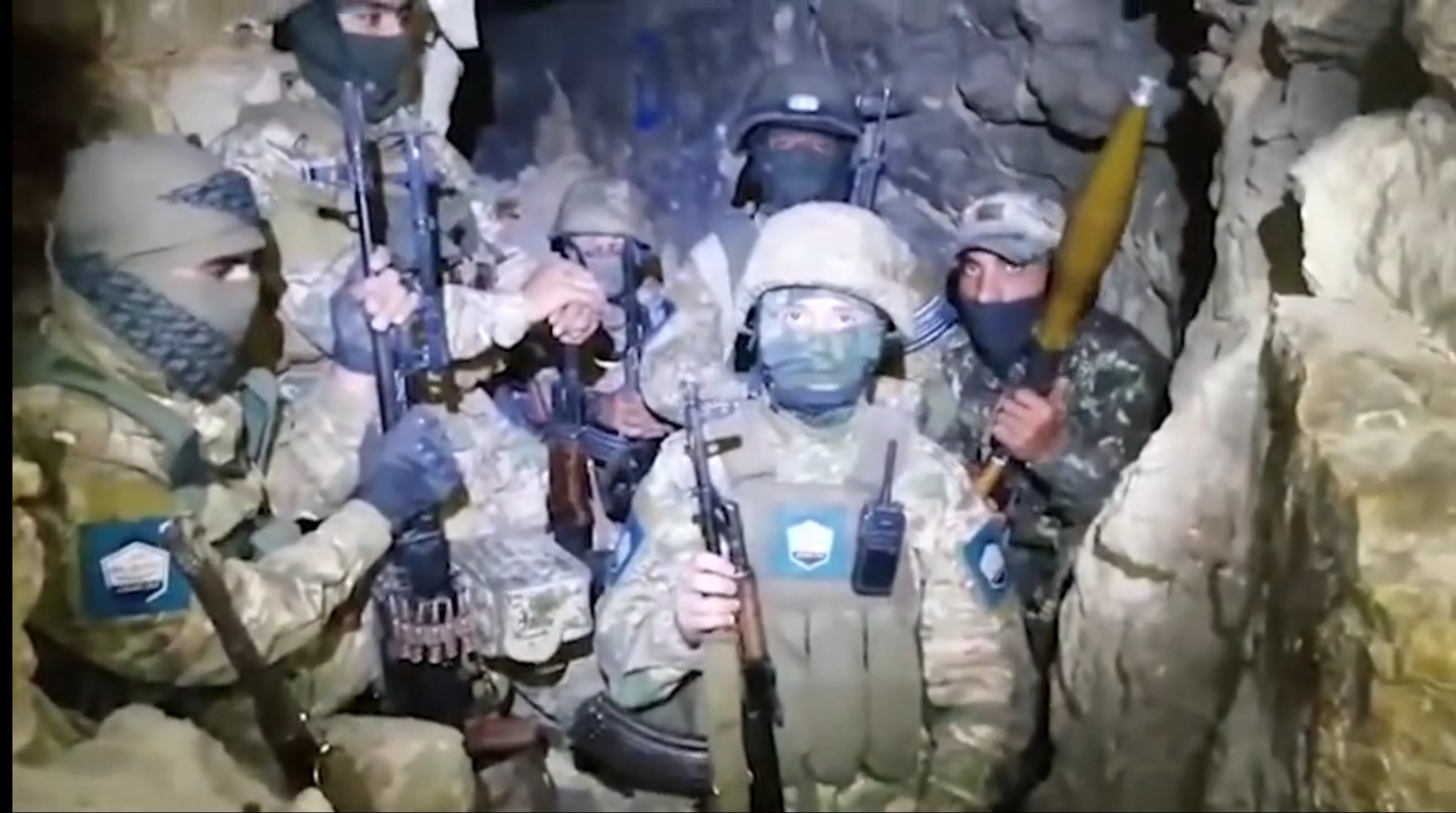
Arrival of the 4th Division
With the massive regime successes of 2017 and 2018, all eyes moved to the last rebel stronghold known as “Greater Idlib.”11.“Fifteen Months of Death: Pro-Government Casualties of the Syrian Civil War” : Bellingcat On April 30, 2019, 4th Division-affiliated Facebook pages began publishing posts about a new operation in the “north Hama countryside and eastern Latakia” that was to be led by the 42nd Brigade under the commander of then-Colonel Gaith Dalah.12.https://justpaste.it/72wjk
The map below shows the Kabani front looking south to north. Pictures A show satellite imagery from December 4 of the extensive regime encampments. Closer imagery reveals armoured vehicles dispersed throughout these areas. Site B is where the 4th Division deployed it improvised rocket-assisted mortars (IRAM), known as “Golan” launchers. These improvised artillery pieces were used to hammer Jabal Zuwayqat and the town of Kabani. Line C is the main path used by regime forces to assault the hill. Nearly every attack came up this path.

Three posts on May 5 by a 42nd Brigade-affiliated Facebook page confirmed the 4th Division’s arrival in Kabani. The first post claimed Col. Dalah and units of the allied Arab Nationalist Guard were in the Latakia mountains, somewhere between the 4th Division base in Jurin, Hama and the Kabani front. A second post stated that a Golan operator of the 42nd Brigade was wounded while “bombing in the vicinity of Jisr al-Shughur.”13.https://justpaste.it/3evmj Lastly, pictures surfaced of 4th Division Deputy Commander Major General Ali Mahmoud meeting with Col. Dalah and 42nd Brigade fighters in Latakia.


The next day the first reported assault on Kabani began – and ended in failure.14.https://twitter.com/LccSy/status/1125447099322183683 On May 7, rebel factions claimed the deaths of eight regime fighters in their own raid on the mountain.15.https://twitter.com/alwataniaTahrer/status/1125764740914008065 Loyalist pages reported 15 martyrs that day – likely men killed on both May 6 and May 7. Eight of the slain men fought under the 4th Division’s 977th Battalion while seven were members of the 42nd Brigade’s “Zakiyah and Bakar” Groups based out of Damascus and Quneitra. On May 8, Col Dalah officially arrived in Kabani, bringing with him more men and equipment from the 4th Division’s 42nd and 40th brigades.16.https://twitter.com/GregoryPWaters/status/1126381988426870784
The 4th Division began hammering Kabani and Jabal Zuwayqat with their Golan launchers. Between May 7 and May 15, 42nd Brigade-affiliated pages posted eight videos of IRAM barrages. All could easily be geolocated to the valley just south of Jabal Zuwayqat. Satellite imagery available on April 26 and May 26 shows fresh scarring on the ground where the Golan launchers operated in early May.

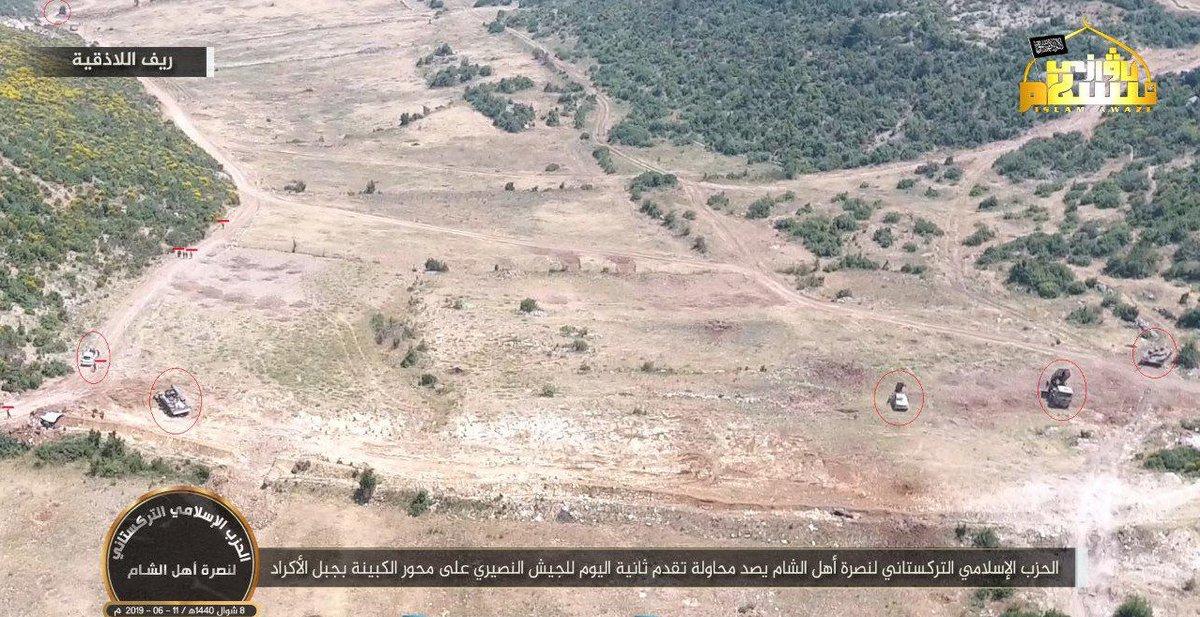
May 12 to May 24: 4th Division Takes the Initiative
While local loyalist forces were stationed nearby, the 4th Division – with no familiarity to the terrain – decided to unilaterally launch its offensive on May 12. Directly ordered by 4th Division Chief of Staff Munzer Salim, the first major assault ended in chaos, with 25 men going missing for 24 hours hours before eventually making it back to 4th Division command. As many as twenty additional pro-regime fighters remain missing from this attack. Rebels claimed to have killed 15 regime fighters, although there were no public reports to support this. However, according to a loyalist source interviewed the next day, “It is difficult to assess who has gone missing because there is chaos at the front now, no names have been released by anyone.”
On May 13, Syrian al-Qaeda affiliate Hurras al-Din carried out its own attack on regime positions in the nearby Tel Rasho, killing at least four members of the “Naval Forces,” a Jaber-family funded militia now operating under the command of the Coastal Shield Brigade.17.https://twitter.com/QalaatAlMudiq/status/1128346038841036803 A member of the 4th Division-affiliated Shawaheen Hawks’ 2nd Battalion was also killed in Kabani while a seventh regime fighter died either in Tel Rasho or Kabani.
By May 15, then-AFI Deputy Commander Ghassan Ismail arrived in Salma, Latakia to attempt to organise a unified offensive against Kabani. Instead, the 4th Division continued to insist on leading the offensive on its own, and with Maher al-Assad’s apparent support, the other pro-regime units were forced to wait on the sidelines.
On May 16 the 4th Division again attacked the hill, this time reporting at least 10 deaths during the failed assault and five NDF fighters missing in action. Rebel drone footage shows a small infantry assault supported by one BMP (knocked out during the attack) and an ARV.18.https://twitter.com/QalaatAlMudiq/status/1129121275664846849 By the end of the day, local NDF sources were claiming more than 40 loyalist deaths since the May 12 attack, as compared to the just 16 publicly announced deaths.
Reports soon surfaced that the regime had conducted a chlorine attack on rebel fighting positions on May 19, likely delivered via the 4th Division’s IRAMs.19.“Pompeo says Syrian government used chlorine in May chemical weapons attack” : CNBC The deaths of two pro-regime fighters were also reported that day. On May 23 the Russian Air Force actively bombed the front for the first time.20.https://twitter.com/QalaatAlMudiq/status/1131615785506484225 At least three more assaults of the hill occurred between May 20 and May 24, resulting in the deaths of at least eight more men – two members of the 4th Corps’ 6th Division and six 4th Division fighters.
May 25 to June 17 – Rebels Strike Back
The next three weeks saw a brutal back and forth between the regime and rebel forces. After more than a week of no serious pressure on Kabani, regime forces renewed their assault, losing at least nine members of the 4th Division’s “Old Damascus Battalion” on June 3.21.https://twitter.com/QalaatAlMudiq/status/1135657051676430336
Rebels responded to the failed 4th Division attack with a new raid on on regime outposts in Jabal Turkmen on June 9. 22.https://twitter.com/QalaatAlMudiq/status/1137709719873884160 The raid killed at least six members of the Border Guard’s 11th Regiment, including the garrison’s battalion commander and a captain.23.https://twitter.com/GregoryPWaters/status/1138554853008007169
A subsequent June 11 assault on Kabani left at least four regime forces dead. Rebel drones observed the attack, showing a 4th Division T-72 tank supporting the small group of infantry and the exposed positions regime forces were forced to take when assaulting Jabal Zuwayqat.24.https://twitter.com/QalaatAlMudiq/status/1138517057761361921 The death of a fifth regime soldier was reported on June 12, although it is unclear if he died then or the day prior.
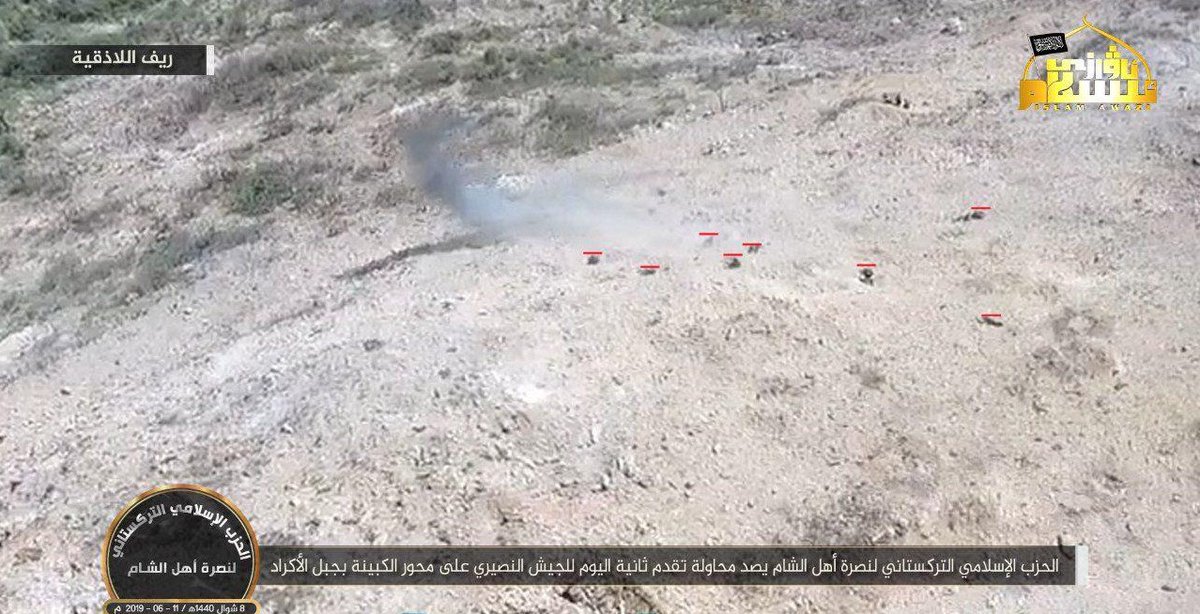
On June 17, rebels carried out their third raid since the start of the offensive, this time attacking regime positions near the village of Ain Ashara, just west of Tel Rasho.25.https://twitter.com/QalaatAlMudiq/status/1140681332412076032 Seven members of the Naval Forces were killed in this attack, including a captain.
June 18 to July 24 – Kabani Goes Quiet
Following a disastrous opening month of the offensive in which at least 97 loyalist fighters died, regime forces did not press Kabani for six weeks – although they did occasionally shell the town and mountain.26.https://twitter.com/QalaatAlMudiq/status/1155532983023165440 Rebel forces also largely went quiet, aside from the occasional ATGM strike elsewhere on the front.27.https://twitter.com/QalaatAlMudiq/status/1144326589884313602
However, on July 9 rebels launched a large attack on Jabal Kanisa, just south of the Turkish border. Rebels systematically targeted three different positions on and around the hill, killing at least 40 regime fighters and capturing three more. Loyalist units involved in the attack included the Border Guard’s 11th Regiment, local NDF, SSNP, and the 144th Brigade of the 4th Corps’ 2nd Division. A breakdown of the attack can be found here and here.
Following this attack the front again went quiet, although a regime airstrike on July 18 managed to kill Faylaq al-Sham’s regional commander.28.https://twitter.com/QalaatAlMudiq/status/1151937493434023941
July 28 to August 31 – New Strategy
On July 28 the 4th Division renewed its assault on Kabani, suffering at least one death. Assaults continued daily for the next four days, with at least 14 loyalist deaths from the Tiger Forces’ Shawaheen Regiment and the 42nd Brigade’s al-Ighwani Group, al-Lord Group, and al-Kuwasir Group.
Assaults on Jabal Zuayqat continued between August 2 and August 12, although at a lower pace. Nineteen more loyalists died here in this period, and one member of the Naval Forces was killed in a rebel ATGM attack elsewhere in the province.29.https://twitter.com/QalaatAlMudiq/status/1159870904236687361
On August 13, the 4th Division deployed its first armoured bulldozer as it adopted a new strategy for taking Jabal Zuwayqat. It was hoped the bulldozers, supported by tanks, could rapidly build fortifications atop the hill, allowing the assaulting infantry to better secure new ground and maintain a foothold from which they could launch new attacks. The first bulldozer deployed was quickly destroyed by rebel forces.
While satellite imagery shows the bulldozers successfully built a number of small berms in subsequent assaults, the strategy ultimately failed. Between August 13 and August 25, the regime continued sporadic assaults, backed by artillery and Russian attack helicopters. At least 11 loyalists died in these failed attempts.30.https://twitter.com/QalaatAlMudiq/status/1165648479252877318

October 24 to December 29 – The Final Push
Between August 25 and September 29 there were nine reported loyalist deaths affiliated with the 4th Division, 2nd Division, and Border Guards. On October 24, regime forces renewed their offensive, two months after their last serious push on Kabani.31.https://twitter.com/QalaatAlMudiq/status/1187432754151075841
This new push brought with it two changes. First, elements of the 5th Division redeployed to the Kabani front and brought with them significant amounts of night vision equipment, which they shared with the 4th Division. Also arriving in Kabani were new Iranian-backed militias, first Syrian Hezbollah’s Ridha Forces and later various LDF units from across the country.32.https://twitter.com/GregoryPWaters/status/1187894065372622849 On October 28 an Iranian adviser to Syrian Hezbollah was killed in Kabani.33.https://twitter.com/QalaatAlMudiq/status/1190235956072321029
Between October 24 and October 31, at least 15 loyalist fighters were killed in Kabani. At least four of the killed men belonged to Syrian Hezbollah while at least two others were members of the 4th Division.
On November 1, rebels again assaulted regime positions in another massive, coordinated attack across the eastern Latakia front. Groups of rebel fighters struck regime positions on Tel Malik, Tel Rasha, and Tel Toubal. Rebels managed to kill the regime commander of the sector’s defences in the attack, a veteran of Latakia battles for years.34.https://twitter.com/GregoryPWaters/status/1190401356319711232 At least 22 regime fighters were killed, including members of the 5th Corps, 4th Division, Naval Forces, and Tiger Forces.
Regime assaults on Kabani continued almost immediately after the rebel attack, attacking on the ground and bombarding the mountain with jets, artillery, and missiles.35.https://twitter.com/QalaatAlMudiq/status/1192160330216022016, https://twitter.com/QalaatAlMudiq/status/1191781022804918273 At least 27 more regime fighters were killed assaulting Jabal Zuwayqat in the month of November, mostly belonging to the 4th Division but also from Iranian-backed units like the Idlib-based Saraya Ra’ed, Latakia-based Fawj Qamr Bani Hashim, and the Hezbollah-affiliated Komeet Forces. On at least one occasion, advancing forces attempted to bypass Jabal Zuwayqat to the east with at least four armored vehicles. However, several of these were quickly destroyed.

Interestingly, in late November a pictured surfaced that appeared to show IRGC commander Kamil Kahansl in Kabani. Kahansl is reportedly the IRGC commander of the Aleppo and Latakia fronts. The picture of Kahansl matches the timing of the arrival of the “Special Tasks Battalion” – an Aleppo-based militia with heavy ties to the IRGC.36.https://twitter.com/GregoryPWaters/status/1204567244572778496


December 1 through December 12 saw intermittent clashes around Kabani with just five reported regime deaths on five separate days. However, beginning on December 17 the regime launched near-daily assaults on the hill, with reported losses every day except December 28. Between December 17 and December 30, at least 38 regime fighters were killed on Kabani, including men from the 4th Division’s 555th Regiment (which had only recently reinforced the front), the Arab Nationalist Guard, the Free Palestine Movement’s Badr Brigade, LDF Special Forces, the Lebanese Baath Forces, and a member of the 1st Division’s 3rd Battalion.
Following these failed assaults, the 4th Division’s 42nd Brigade announced that all objectives in Kabani had been achieved and their men would be redeploying to Aleppo “for new victories.”
The Cost
By the time the 4th Division announced its retreat, 259 pro-govt deaths had been reported across Latakia by loyalist Facebook pages. The actual number of deaths is much higher. Relying on public martyrdom announcements presents several limitations: the men killed must have family or friends who announce their deaths, the researcher must find all of these announcements, many of which can only be found on small community pages, and there must not be pressure against posting deaths. Martyrdom posting occurs in waves, with regular intervals in which the state suppresses such announcements for various reasons. Throughout the month of May, for example, Syria faced an acute fuel crisis and much anger in core loyalist areas. According to one loyalist soldier from the coast, death announcements nearly ceased in order to not further anger affected communities.
Loyalist military sources have provided the author with some death counts which prove that 259 is an under count. Between May 12 and May 16, there were at least 40 pro-regime deaths in Latakia, but only 16 were publicly announced. On August 9 the regime suffered 14 deaths in its first of three assaults on Kabani, but only one death could be found publicly for the entire day. On December 25, six members of the Lebanese Baath Forces were ambushed near Kabani, their dead bodies decapitated and shared publicly, but only one of their deaths was reported publicly by the unit.37.https://twitter.com/Ibra_Joudeh/status/1209920239087034368
While the offensive took place over 237 days, deaths were only reported on 79 days. As seen in the chart below, there were several lengthy periods in which little to no fighting too place in the province.

Despite the steady losses, few high-ranking men were killed during the Kabani attacks. Based on publicly reported deaths, only four commanders died attacking Kabani: a group commander of an unknown unit, the commander of the 3rd Company of Saraya Ra’ad, an LDF special forces field commander, and an Iranian advisor embedded with a Syrian Hezbollah special forces unit. On the broader Latakia front, rebels killed a Border Guards 11th Regiment battalion commander and a captain on June 9, a captain in the Naval Forces on June 17, a captain from an unknown unit on July 9, and a battalion commander from the 5th Corps’ 1st Storming Brigade on November 1.
As shown in the chart below, the largest proportion of killed loyalist fighters came from Damascus and its countryside. This makes sense when considering that the 4th Division is one of the biggest recruiting units in those provinces. But as with all regime offensives, a significant portion of deaths came from the Alawite heartlands of Latakia, Tartous, and Homs, accounting for 32% of all reported deaths.
Home Province of Loyalists Killed in Latakia
The large representation of Damascus-born fighters is also due to the conscription of reconciled rebel fighters and civilians from ex-opposition towns into the 4th Division. Throughout the offensive there were many theories that the regime was simply trying to rid itself of ex-rebels – thus the seemingly incompetent suicide attacks on Kabani could be explained away as a clever trick.
Examining the status of the hometowns of these Damascene martyrs reveals that approximately two-thirds of these men came from towns that were at one point under opposition control. However, half of these men came from towns that fell to the regime at some point in 2014 or 2015, when reconciliation was still in its infancy and many towns were simply emptied of their anti-regime citizens when captured. Regardless, if all of these men were indeed ex-rebels it would still only account for 18.5% of all reported deaths – hardly supporting the above-mentioned theory.
Status of Hometown for Damascus-born Loyalist Martyrs
According to armour analyst Jakub Janovsky, pictorial and video evidence confirms the destruction of at least ten armoured vehicles – including seven tanks – and at least two damaged T-72 tanks. Rebel forces claim to have destroyed additional vehicles, claims supported by the fact that 4th Division tank operators were reported killed on August 20 and November 30, both days during which there was no visual evidence of destroyed armour. According to twitter user Qalaat al-Mudiq, regime forces also lost at least a half-dozen armoured bulldozers.

On to Aleppo But Kabani Remains
This small town represents the only real rebel victory since the spring 2017 battle of Manshiyah, Dara’a, in which rebel factions managed to fend off a concerted 4th Division and Hezbollah offensive on Dara’a city (the entire governorate would surrender a year later). But the victory in Kabani means little in the broader context of Syria. The bulk of the 4th Division is redeploying to Aleppo, where they may open a new front on the beleaguered fighters of Idlib and the millions of civilians trapped under Russian and Syrian bombardment.
For now, the 4th Corps’ 2nd Division will take over command of the Kabani front, joining the remnants of the 4th Division’s 40th Brigade and a host of local pro-regime forces. While the fighting may ebb for the winter, Jisr al-Shoughur, and its defensive cornerstone of Kabani, remain a key prize if the regime hopes to retake all of Idlib. Whether the regime changes tactics for the next offensive remains to be seen, but a new Kabani offensive is an almost certain guarantee in 2020.
References
